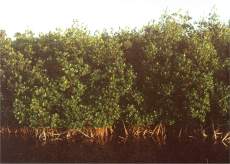
 |
Ecological Importance
 Printable Info Sheet
Printable Info Sheet 
Mangrove trees are an indigenous species to tropical as-well-as subtropical regions with approximately 70 idenitified species worldwide. They are a major contributor to the littoral and marine environments. Mangrove trees are halophytes, plants that thrives in salty conditions. Mangroves have the ability to grow where no other tree can, thereby making significant contributions that benefit the coastal ecology. Their coverage of shorelines and wetlands provides many diverse species of birds, mammals, crustacea, and fish a unique, irreplaceable habitat. Mangroves preserve water quality and reduce pollution by filtering suspended material and assimilating dissolved nutrients.
 |
The tree is the foundation in a complex marine food chain and the detrital food cycle. The detrital food cycle was discovered by two biologists from the University of Miami, Eric Heald & William Odum, in 1969. As mangrove leaves drop into tidal waters they are colonized within a few hours by marine fungi and bacteria that convert difficult to digest carbon compounds into nitrogen rich detritus material. The resulting pieces covered with microorganisms become food for the smallest animals such as worms, snails, shrimp, mollusks, mussels, barnacles, clams, oysters, and the larger commercially important striped mullet. These detritus eaters are food for carnivores including crabs and fish, subsequently birds and game fish follow the food chain, culminating with man. Many of these species, whose continued existence depends on thriving mangroves, are endangered or threatened. It has been estimated that 75% of the game fish and 90% of the commercial species in south Florida rely on the mangrove system. The value of red mangrove prop root habitat for a variety of fishes and invertebrates has been quantitatively documented. Data suggest that the prop root environment may be equally or more important to juveniles than are sea grass beds, on a comparable area basis. Discovery of the importance of mangroves in the marine food chain dramatically changed the respective governmental regulation of coastal land use and development.
The beneficial effects mangroves have on the marine ecology are summarized as follows :
- Basis of a complex marine food chain.
- Creation of breeding habitat.
- Establishment of restrictive impounds that offer protection for maturing offspring.
- Filtering and assimilating pollutants from upland run-off.
- Stabilization of bottom sediments.
- Water quality improvements.
- Protection of shorelines from erosion.
 |
The dikes now prevent the free flow of water and movement of organisms between the mangroves and intracoastal waters, thereby denying the marine ecology the full benefits of mangrove wetlands.
Development and population growth will continue to have a negative impact on mangrove habitat necessary to maintain commercial and recreational fisheries. Based on analysis of aerial photos from the 1940's to the 1980's, one study of the Indian River from Sebastian Inlet south to Vero Beach, Florida, documented an 86 percent decline in the availability of mangrove habitat to fisheries over the forty year period.
Escalating pressure on mangrove populations and increasing quantities of pollutants reaching coastal and intracoastal waters has brought new interest in the importance of mangroves to a healthy marine ecology. As natural members of the estuary system, mangroves help mitigate the environmentally adverse effects of development and pollution.
